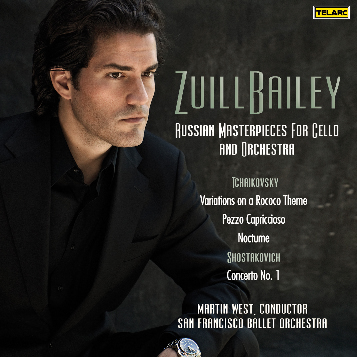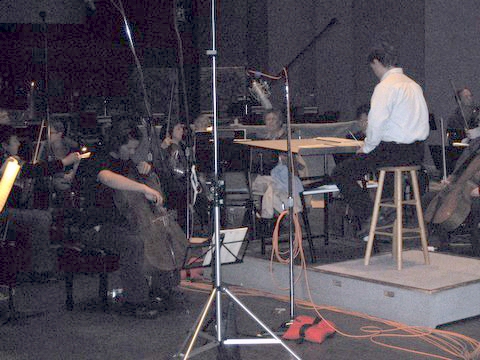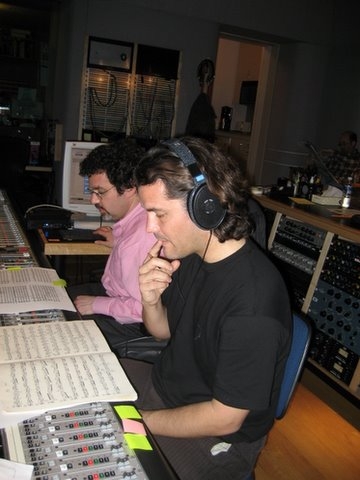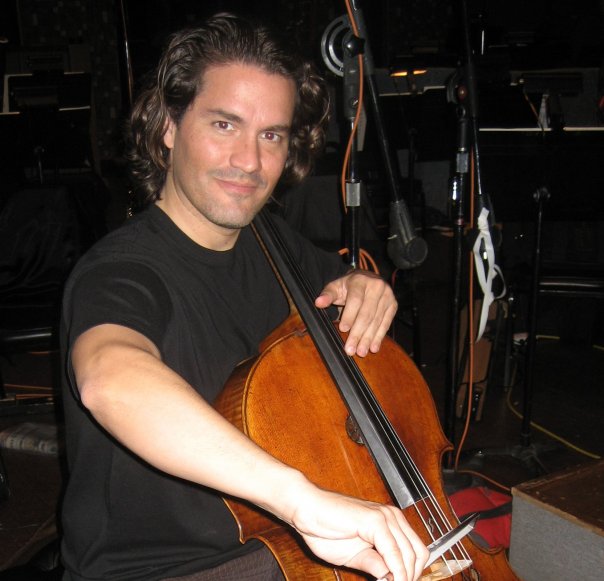Zuill Bailey Records
Shostakovich and Tchaikovsky
February 15-17, 2007
by Tim Janof

Zuill Bailey RecordsShostakovich and Tchaikovsky
February 15-17, 2007by Tim Janof |
 |
Creating a supercharged atmosphere on CD is a no small task. In live concerto performances, one plays with focused intensity for perhaps thirty minutes, which is strenuous enough. Now imagine sustaining a manic energy level for ten hours straight, two days in a row, like sprinting in an entire marathon ... twice. Members of the orchestra continued to send Bailey enthusiastic e-mails for days after the sessions ended, expressing their astonishment at his stamina.
Bailey invited me to witness the recording sessions for his Russian Masterpieces CD, which took place over two long days at Skywalker Ranch, a sprawling 3,000 acre facility tucked deep in the rolling hills of Marin County, north of San Francisco. The property was acquired by George Lucas from his Star Wars earnings, and is sparsely populated with understated buildings that discreetly contain state-of-the-art audio and film production facilities. The main recording studio building feels like a rustic lodge at first, but a wrong turn reveals a futuristic computer room that is the technological heart of a catacomb of editing suites. The entire ranch was eerily tranquil as the employees diligently edited top secret projects in their sound-proof rooms. We rarely saw anybody other than roving security details, but we sensed we weren't alone. Security was extremely tight and one was never sure where the cameras were that must have been watching our every move.
The recording facility at Skywalker Ranch, Skywalker Studios, is managed by Leslie Ann Jones, a Grammy Award-winning producer and daughter of the late Spike Jones. She hires high-level Bay Area professional musicians for recordings, usually movie soundtracks. Outside organizations can also rent the recording studio, as was done in this case. The 50-person San Francisco Ballet Orchestra was brought in, including their conductor, cellist Martin West, who knew the pieces intimately, which saved valuable time.
What follows is a behind-the-scenes view of how recordings are made, though the process for this one was more manic than most. There was a sense of managed chaos due to the quantity of music being recorded in very little time and due to Bailey's desire to create a live performance feeling in the end product. Recordings by other artists, though often beautiful in their own way, can have a feeling of being too much in control, perfectly worked out, and polite, even. Bailey went for something much more visceral by playing every take as if he were in concert, something that the great artists of yesteryear also strived for prior to the advances in recording and editing technology that forever altered and perhaps dominate today's recording process.
The first session began at 9am. Bailey armed himself with Advil and Power Bars. He was determined to come out with guns blazing and he knew he had a long day ahead of him: "I'll need these later." But he was already having doubts and said to me, "If you hear something weird please let me know. I'm starting to question myself." He had recently discussed the Shostakovich Concerto with his friend, Wendy Warner, who mentioned some common mistakes Rostropovich had noted over the years, and Bailey wanted to make sure he didn't do them too. He handed me his score with marked notes so I could verify that he played them correctly, notes that go by so fast that almost nobody would notice the difference. He then discovered a new fingering at the last minute while warming up during sound checks with the orchestra, "I finally found the fingering I need!" This little vignette made it clear that recordings are just snapshots in time, not a final account of how musicians believe a piece should be played.
Bailey and the orchestra started with the first movement of the Shostakovich First Concerto and Adam Abeshouse, who produces all of Bailey's CD's, was soon troubled in the sound booth, "That doesn't sound like Zuill!" Abeshouse understands what sound Bailey is looking for and the cellist that came through the microphone was sounding like somebody else. He had already determined the night before that Bailey needed to sit on the floor instead of the podium in order to maximize his clarity and resonance, but something had changed since his initial set-up. After an initial run-through of the first movement, Adam ran into the sound studio and banged his knuckles on the wood floor in order to find the most resonant spot for the endpin. He then ran back to the sound booth and asked the group to start again. It was still not right. Abeshouse stopped the orchestra and adjusted Bailey's microphone once more. They started again and a velvety resonance suddenly came through the booth's speakers. "Ah, that's Zuill!"
But then the principal french horn sounded fuzzy. Abeshouse ran back in and pointed the horn section's microphone more towards the principal's mouthpiece instead of behind it and all was well again. Abeshouse was finally satisfied.
After several sweeps of the first movement, each one turbocharged, they began to work on the slow second movement. The orchestra did not know the Shostakovich Concerto, and Bailey and the orchestra had never rehearsed it together. This made the slow movement especially challenging due to its musical difficulties. Abeshouse took an active role in rehearsing the orchestra from the sound booth via the intercom system, since some subtleties are easier to discern through the objective ears of the recording system than from the podium. Abeshouse stopped the orchestra frequently, making musical suggestions such as, "Start vibrato before beginning the slow movement � follow the hairpins more closely.'' Clearly, the musicianship of the producer greatly impacts the quality of the final product. He had the orchestra do one take with and another without mutes so that the transition to mutes can be made seamlessly through the magic of digital editing. Mute placement is remarkably noisy when done in unison.
Keep in mind that multiple takes were typically for the orchestra's benefit, not Bailey's. It's difficult to get all musicians in a large group to play perfectly at the same time. Just one burble or squeak from the winds, or a scratch from the strings, and another take is needed. Note that Bailey had to hit the takes pretty much perfectly every time so that each one can be used in the event that everything comes together.
The starting and stopping began to wear on Zuill, who asked that larger chunks be recorded since it was hard for him to maintain the emotional continuity of the phrases. Abeshouse reluctantly agreed, "Ok, I'll do it, but it's against my better judgment." Thus was planted a seed of tension that became a recurring theme throughout the remainder of the two days.

After the several takes, Bailey muttered to himself, "Keep the focus, keep the focus�." He was running out of steam and they were still working on the second movement. Adam commented that Bailey is often a "two-take guy," meaning that he usually gives his absolute all during the first two takes as if they are live performances. Then he deflates for awhile and one has to wait for Bailey to rally.
At 11:45, they zigzagged their way through the second movement up to the cadenza. Bailey once again expressed his frustration with the recording process. "The slow movement is too hard to break up. I have a hard time maintaining the emotional context and I get tight when I do small sections. I feel so naked in front of the microphone."
There were moments of levity, at least in the booth. Abeshouse said to Bailey at one point through the intercom system, "You sound great except when you *$&# up." Bailey semi-glared back through the recording booth glass. When the celeste -- a keyboard instrument that makes bell-like tones -- played in the slow movement, Abeshouse said, "Third floor, lingerie!" The producer is more free to joke around since there are no incriminating microphones in the booth.
We were on "union time," so at noon the orchestra voted on whether to continue rehearsing or to break for lunch. They had thus far recorded in 40-minute maximum sections per hour according to their rules, which meant that there was less than two hours of actual recording time after the sound checks. It was agreed that the orchestra would keep playing and lunch began at 12:30pm. Bailey tended to avoid listening to the playbacks during breaks because he knew he would become too analytical about his playing and would start to question everything, which is not what one wants to do when the pressure is on. When they returned at 2pm, it was time to work on the second movement again. Abeshouse rallied the troops, "Let's Russian rock-n-roll!" After several intense takes that again zigzagged through the entire movement, Bailey broke out the Power Bars and the Advil. He was starting to fatigue.
At 3:15pm they finally began the last movement, which is a punishing movement to play in itself, let alone after a full day of recording. Somehow Bailey managed a sparkling spiccato even though he said his arms felt as if they were going to fall off. At 3:35pm we were informed that the orchestra was scheduled to quit at 4:30pm instead of 5pm, which was news to Bailey and Abeshouse. This was a concern because there were still ensemble issues to iron out. Once the orchestra is gone, one had better have usable takes or no recording will be released, and there was much work to be done in the last 55 minutes. Suddenly, Abeshouse became very tense, given what was at stake if he didn't get what he needed. At 3:50pm and after yet more visceral takes, Bailey finally cried, "My hands are breaking down!' But he soldiered on, even though his intonation began to waiver.
Faced with extreme time pressure Abeshouse took complete charge of the process, "Four before 67. Shut up, please!" At 4:11pm, Bailey downed another Power Bar, but his fine motor control was on the verge of collapse. The next takes occurred at Abeshouse's frantic direction and there were still intonation problems in the orchestra. Suddenly, at nine after 62, Bailey played a certain high note noticeably more beautifully than he had in previous takes and Abeshouse declared, "That's a keeper!" Where did that miraculous beauty come from all of a sudden? Moments later, Bailey found his second wind and there was a scramble to get a few more takes in the remaining minutes. Then with almost no time left, Bailey cursed to himself through clenched teeth as he struggled to get one last thing, something that he ordinarily had no trouble with. And then it was quitting time and the orchestra packed up and left.
Bailey, who was clearly in no condition to continue, then wanted to record the cadenza. After only a 25 minute break, he began playing. It was just me and Bailey in the recording studio at that point with Abeshouse and his assistant, Andy Ryder, in the booth. After a couple of run-throughs, however, Bailey had a dizzy spell, "I must stop. I have no creativity left. I'm just playing the notes!" He then laid down flat on the floor silently, completely burned out. After a few minutes Abeshouse went in and sat next to him without saying a word. Bailey eventually composed himself and picked up his cello and started again. After several more takes, I, who had been respectfully quiet the entire day, for some strange reason felt compelled to ask Bailey if he might try shaping the phrases a bit more. The exhausted glare I got from Bailey and the horrified "Tim!" that blared from the sound booth's intercom system made it clear that my timing left much to be desired. "Sorry sorry sorry I'll shut the hell up! Sorry." Ugh. Bailey was so tired that hitting the notes was about all he could do at this point. At 6:48pm, almost ten hours later, Bailey gave up.
Imagine you have just run a marathon and the next day you have to do it all over again. That's what it was like for Bailey on Day Two. He dragged himself out of bed and readied himself for a very different style of music. Rather than the, at times, harsh Shostakovich Concerto, he had to play the refined Rococo Variations and other Tchaikovsky works, despite the fact that he felt completely beaten up. The orchestra was delighted "to actually play a melody" and to play a piece they had performed many times in ballet form. In order to psych himself up for the long day, Bailey unleashed some vigorous and yet comedic kung fu moves in the booth.
The orchestra began without Bailey at first. Adam Abeshouse suggested the strings use a narrower vibrato in order to make the intonation pristine, which worked immediately. After several takes Bailey joined in. He got his bowing in the opening bar from Rostropovich. Rostropovich, who conducted the National Symphony in Washington, D.C., was in essence the "house solo cellist" for the orchestra when Bailey was growing up nearby. Bailey played the first four eighth notes as down-down-up-up instead of the International Edition's up-up-up-up. Rostropovich's bowing works well because it clarifies one's sense of the quarter note beats, while still allowing the cellist to lead the music to the next bar.
Bailey took Variation II at a lightning fast tempo: "I want something like horses out of the gate." But things became tense as it was discovered that the orchestra didn't have bar numbers in their parts and precious time was burned trying to figure out where to start. This greatly unnerved Abeshouse, who had a large clock staring at him the entire time. At 11:15am, they decided to run through the entire piece rather than starting and stopping. At the end of Variation II, Bailey commented, "My adrenalin is pumping like crazy!" which explained why he accelerated right away instead of following the "stringendo poco a poco" marking. At one point I commented to Abeshouse that Bailey always slid up to a high harmonic in the same way. Abeshouse replied, "Don't worry. He hit that in Take 3." Soon after, Rococo was considered done, at 2:45pm.
Only two hours were left with the orchestra and none the short pieces had been touched, including the blistering Pezzo Capricioso. Imagine playing Pezzo after a full day of Shostakovich and most of the next day Rococo. Bailey somehow managed to find what must have been his tenth wind by then. After several takes of Pezzo, Bailey pleaded to Abeshouse to not disrupt his flow with too many starts and stops, "Don't make me conscious of this yet!"
Eventually, Abeshouse had had enough of Baileys' desire for long sections. "Zuill doesn't understand that every time we start too far back, we don't get to work on problem areas that occur much later." Eventually, Abeshouse managed to get some clean takes and all was well.

Zuill Bailey and Adam Abeshouse listening to various takes.
Abeshouse is a master at reading people and understands the need to balance his needs as the producer with the psychological needs of the musicians, "My job is about managing time, managing people's emotions, and managing how they learn. Sometimes it's better not to say anything." I watched as Abehouse heard something he didn't like in the orchestra part but restrained himself from saying something because he had faith the orchestra heard it too and would fix it themselves, which they generally did. When Bailey, now beyond tired, struggled with a particular passage, Abeshouse said the magic words that got things back on track, "Don't push it. Let it guide you," words of wisdom that sounded as if they were from a Star Wars script.
With only 30 minutes left, it was decided that Pezzo was complete. They recorded the Tchaikovsky Nocturne for the next seven minutes -- two takes -- and then, interestingly, took a ten minute break. No time for the Andante Cantabile. Then they hopped around the Shostakovich Concerto for another 20 minutes, with Abeshouse barking out measure numbers, "Bar 49-90� Nine before 65�. Come on!" And then, at precisely 4:40pm, the session with the orchestra was over. The orchestra applauded, packed up, and left Bailey, Abeshouse, Andy (Abeshouse's assistant), and me in the now deafeningly quiet studio.
At 5:15pm, Bailey decided he wanted to try the cadenzas one more time. After a few Rococo excerpts, it was back to the Shostakovich, but not until a fine bottle of Duckhorn wine was uncorked and poured in front of the microphone. The glug-glugging of the wine was a mesmerizingly serene sound after two days of intense music-making. We raised our glasses to Bailey's herculean effort over the last two days.
After a 30-minute break, at 5:50pm, Bailey picked up his cello and began again. Six minutes later, he discovered a better fingering for a particular section in the Shostakovich cadenza. Then something amazing happened. Bailey pulled out one of the most insanely energetic and hair-raising Shostakovich cadenza performances imaginable. It was as if he were a rock star blazing out a guitar solo. Where did that come from? And what timing! Now it was time to stop for good, more than ten hours later.
That night we celebrated by having dinner with world renowned pianist Garrick Olson at the ambiance-free Yuet Lee Seafood Restaurant in San Francisco, a favorite of Garrick Olson and the late Isaac Stern. Olson arrived wearing a delightfully unassuming red plaid sweater while carrying a cloth bag full of assorted bottles of wine, including some that had no label. Olson said that he likes "odd stuff," and the unlabeled wine was definitely a bit odd and quite bitter. Olson asked the owner to surprise us with whatever food he felt like bringing, as long as it wasn't too "adventurous," since the rest of us weren't ready for non-standard parts of various creatures. Definitely seek out this restaurant, the food is amazing.
The talent at the table was staggering: two soloists (Olson and Bailey) and two Grammy Award-winning producers (Abeshouse and Leslie Ann Jones), as well as conductor Martin West. Feeling rather undeserving to be at the table with these overachievers, I at least had the dubious honor of discreetly informing Garrick Olson of the cilantro in his teeth.
In addition to being regaled by Martin West's no-holds-barred Monty Python imitations (British people have a certain advantage when doing these), our conversation included a discussion of Rostropovich, who at that time was in the hospital in Moscow. Olson remembered being "blown away" as he watched Rostropovich do one of his formidable concerto cycles in the 1960's. Olson also recalled warming up before a concerto performance many years later with Rostropovich as conductor. Olson was noodling with the Prokofiev Second Piano Sonata backstage when Rostropovich stuck his head in and begged, "What is that piece? I know it but I can't remember what it is. It's driving me crazy!" Rostropovich, greatly relieved when Olson told him, launched into a discussion of the history of the piece and what Prokofiev was doing at that time in his life. Although there were many stories left to share between those of us at the dinner table, we all looked at our watches and realized it was already midnight and time for us all to go our separate ways.

It has been almost two years since these recording sessions took place. My experience was life-altering and humbling. I now listen to recordings with much more appreciation, even ones that I like less, since I understand how grueling the process can be. Though there are many takes, there really are no second chances in the larger sense. You can't make a great cello recording unless you are a great cellist to begin with. Technology allows one to choose the best takes in various sections, but the cellist still has to do the transcendent playing. There's no addition of reverb or splicing that can make a mediocre cellist sound truly great. And it takes a great cellist like Zuill Bailey to play something over and over, take after take, at such a high level. My hope is that the next time you hear a recording that isn't to your liking you remember this account.
I also appreciate even more the legendary musicians of the past, who recorded in a time before the emergence of the digital editing technology that we now take for granted. It takes a wonderful musician to sound that good with only limited editing help. The orchestra's concertmaster recalled watching Jascha Heifetz make a recording of Mozart concertos. Heifetz did a single run-through of two concertos in the morning. He did the same thing in the afternoon. This was repeated the next day: two in the morning, two in the afternoon. Then he put his violin away, thanked the orchestra, and left. That was it. It must have been more satisfying to record back then, at least in certain ways, which is the experience Zuill Bailey was fighting to re-create.
I now have a copy of the CD. Of course, it's impossible for me to listen to it without memories flooding in. Having gone through the process alongside Zuill Bailey, I hear clearly how he managed to achieve his goal of capturing the energy of a live performance, and yet he managed to do so without swallowing the musical details. You will want to turn up the volume on this CD, especially for the Shostakovich, so you can be enveloped by the music's teeming emotion and Bailey's bellowing cello.
I recently asked Bailey how he feels about this experience and his recording now that he's had two years to reflect. He indicated that the recording sessions were the culmination of a long journey, in which he completely immersed himself in the music, the composers, and discussions with colleagues, but his journey continues.�� He is pleased with the recording, and he said�the recording process itself pushed him to another level, so his approach to the works on the CD has certainly evolved.� He intentionally took a break from performing the Shostakovich and Rococo for a year afterwards so that this recording experience could sink in.� He is now playing these pieces again,�and he finds that he has fresh ideas and deepened feelings.� "Recording the Russian CD was an amazing experience and I have such�wonderful memories to savor for the rest of my life. Whenever I think about this project, I am reminded of how important it is to enjoy and truly live the processes in life.� Goals come and go, but the way one gets there seems to change everything."
Late breaking news: I just watched Zuill Bailey record the Bach Cello Suites. More on this later.
1/21/09

| Direct correspondence to the appropriate ICS
Staff Webmaster: Tim Janof Director: Tim Janof Copyright © 1995- Internet Cello Society |
|---|